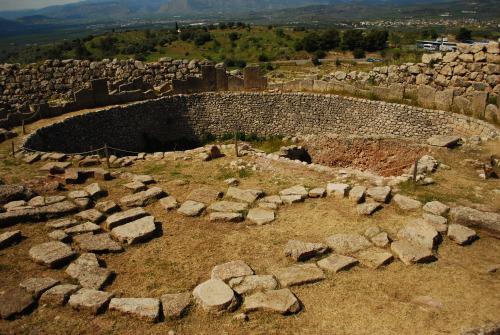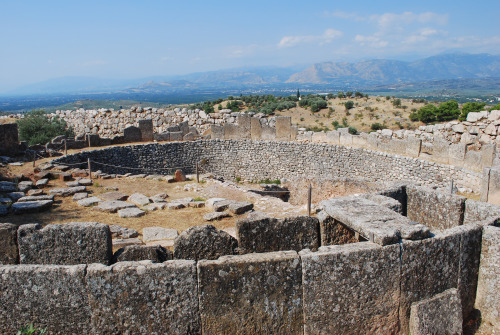ancientart: Grave Circle A in Mycenae is a 16th century BC royal cemetery situated to the south of t
ancientart: Grave Circle A in Mycenae is a 16th century BC royal cemetery situated to the south of the Lion Gate, the main entrance of the Bronze Age citadel of Mycenae, southern Greece. Once part of a large cemetery outside the acropolis walls, Grave Circle- A was discovered within the Mycenaean citadel by Heinrich Schliemann, who excavated it in 1876 under the supervision of the Greek Ephor of Antiquities Panagiotis Stamatakis. Grave Circle A comprises six rectangular vertical shaft graves, which measure from 3.0 by 3.5 meters in width to 4.5 by 6.4 meters in length. These shaft graves consist of two parts: the main shaft itself, which is cut into the bed-rock and a larger pit surrounding it. After the grave goods were deposited in the main shaft, a wood or flagstone cover supported by the shaft’s sides was set in place and the larger pit was filled with earth. The tombs in Grave Circle A contained a total of nineteen burials: nine males, eight females and two infants. With the exception of Grave II, which contained a single burial, all of the other graves contained between two and five inhumations. The deceased were placed on their backs, generally on an east-west axis. Schliemann cleared Graves IV and Stamatakis excavated Grave VI one year later. The pottery finds from Graves I, II, III and VI indicate a range of dates from the end of the Middle Helladic period to the Late Helladic IIA period, that is, from the 16th to the early 15th centuries BC. The amazing wealth of the grave gifts reveals both the high social rank and the martial spirit of the deceased: gold jewelry and vases, a large number of decorated swords and other bronze objects, and artefacts made of imported materials, such as amber, lapis lazuli, faience and ostrich eggs. All of these, together with a small but characteristic group of pottery vessels, confirm Mycenae’s importance during this period, and justify Homer’s designation of Mycenae as ‘rich in gold.’ The discovery of Grave Circle A startled the entire world with its momentous finds. It brought to light a great and hitherto unknown civilization, and paved the way for the study of Greek prehistory. The excavation of Mycenae has expanded Schliemann’s fame and gave him the title of the “father of the Mycenaean archaeology”. (via greek-thesaurus) Photos courtesy & taken by Jeanhousen -- source link
#mycenae#mycenaean#bronze



